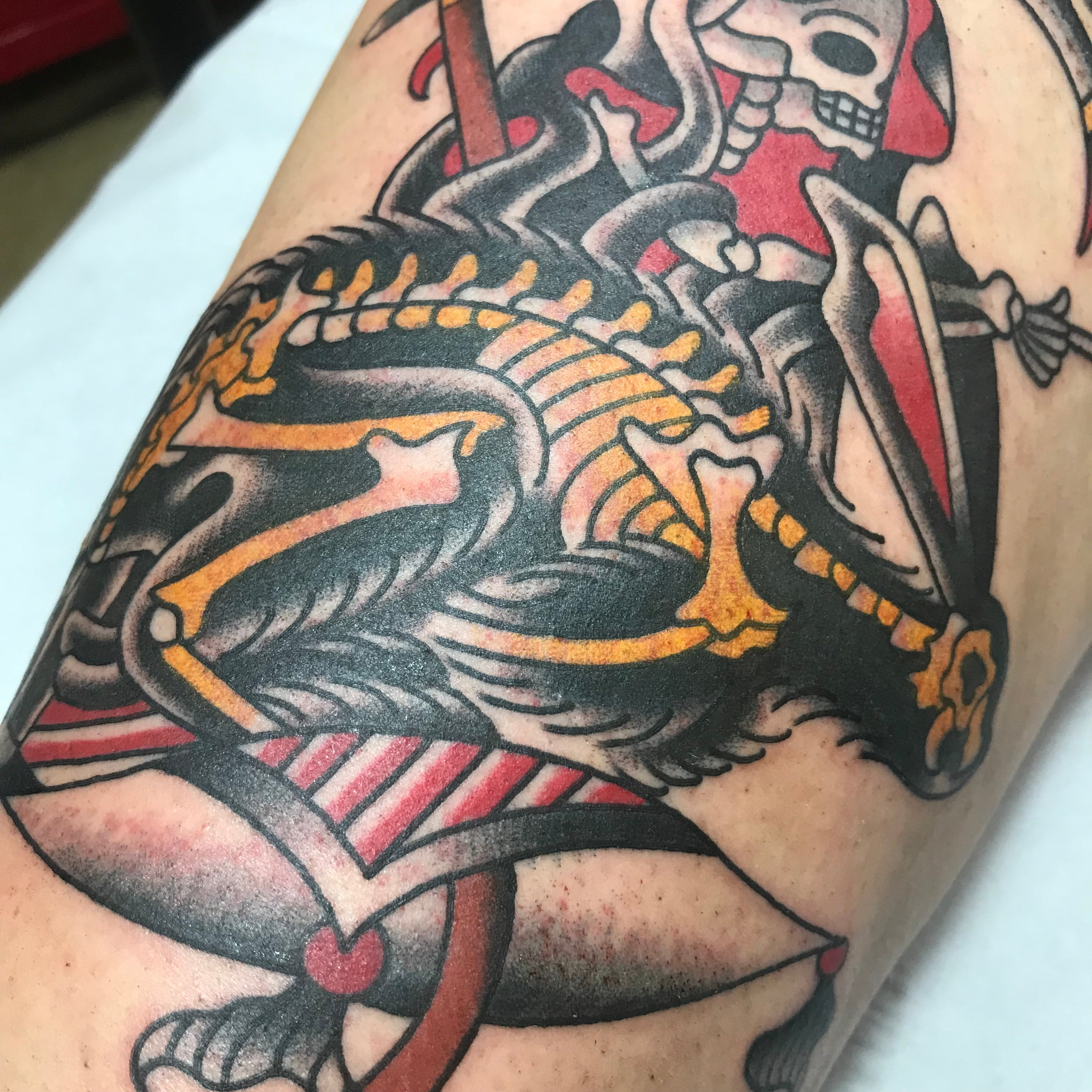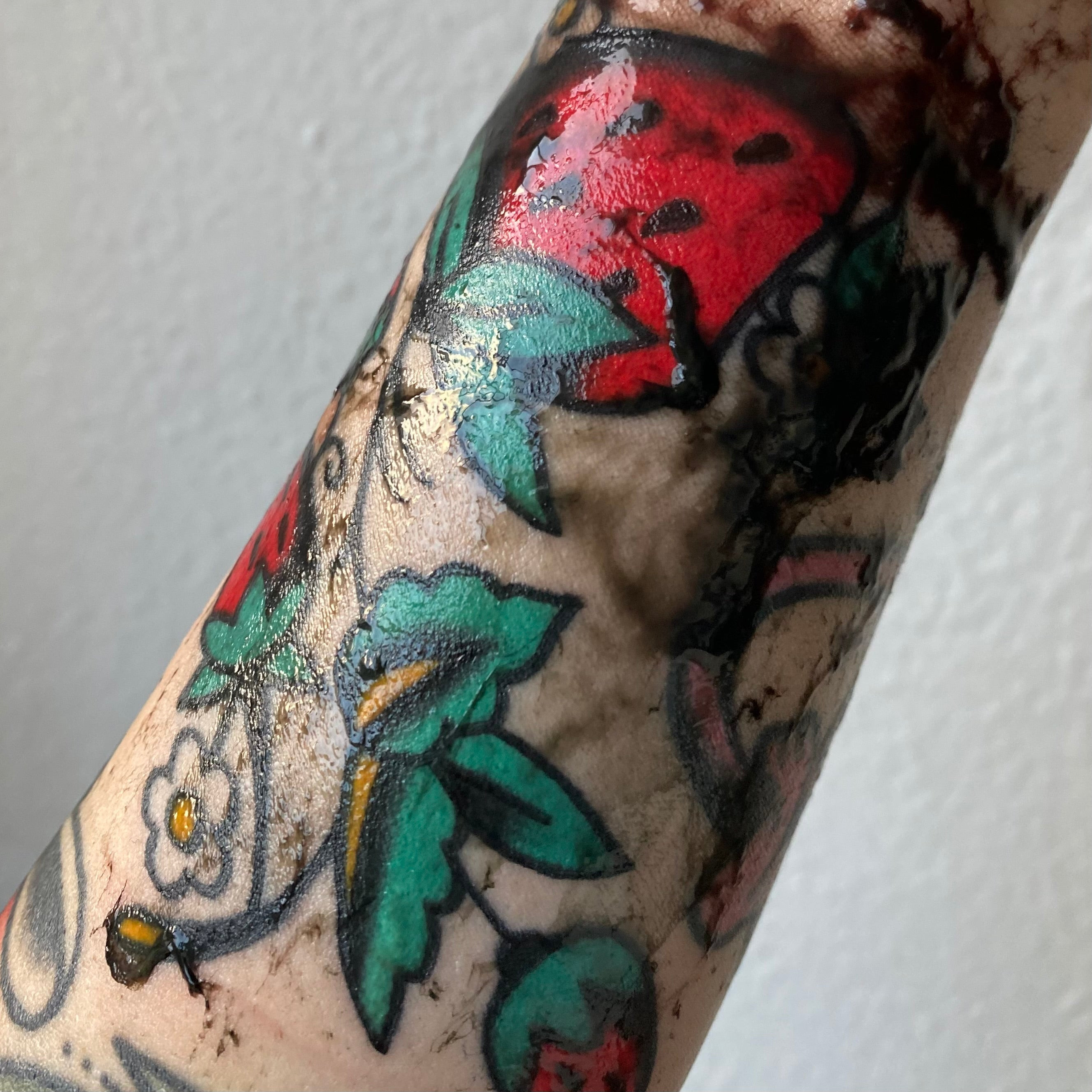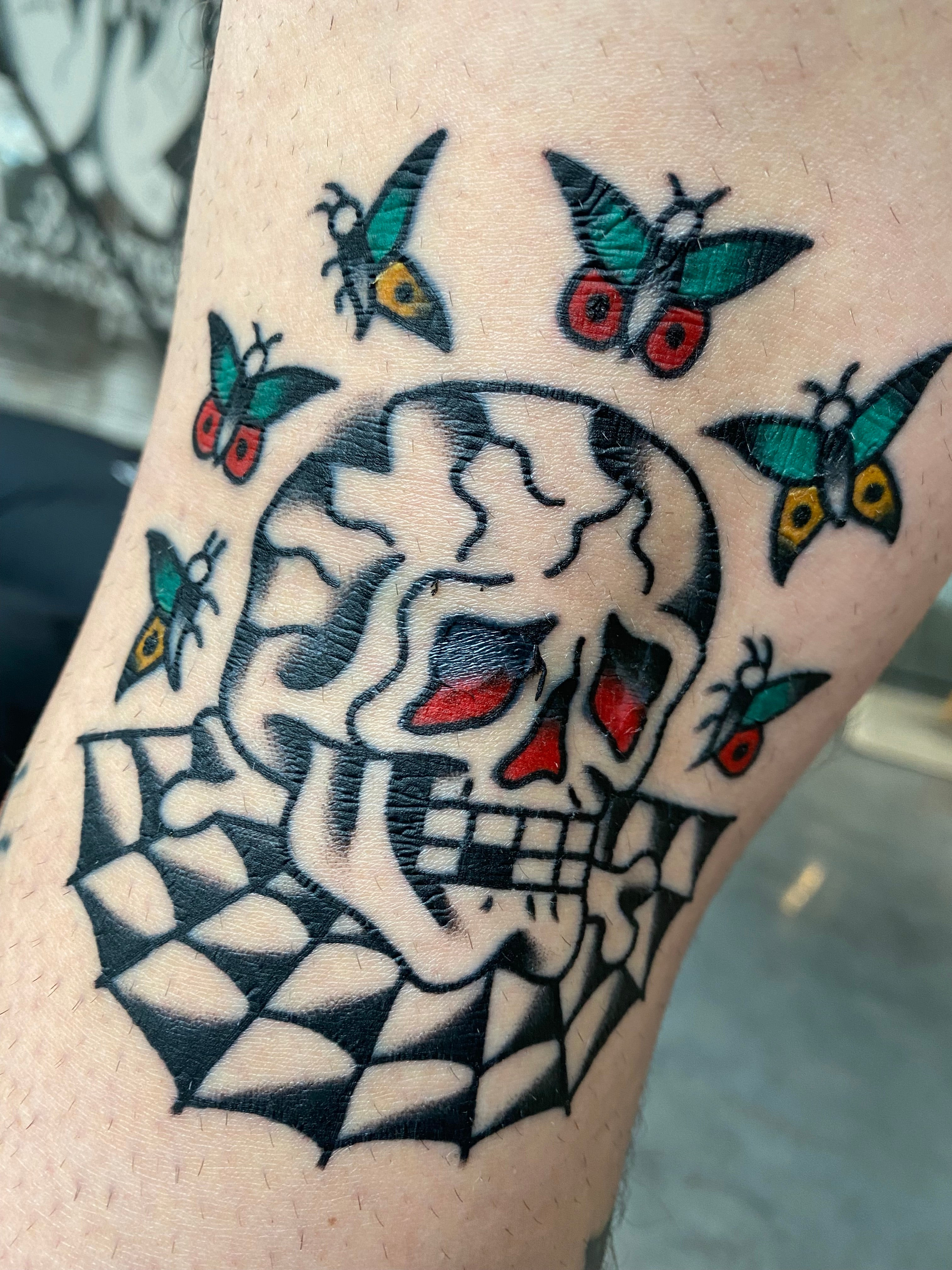Are Tattoo Infections Common? No, tattoo infections are relatively uncommon if proper hygiene and aftercare are followed. Tattooat.com is here to guide you through identifying potential infections, understanding treatment options, and learning preventative measures to ensure your body art remains vibrant and healthy. With the right knowledge and care, you can minimize the risk of infection and enjoy your tattoos for years to come.
1. Understanding Tattoo Infections
Tattoo infections occur when bacteria, viruses, or fungi enter the skin during or after the tattooing process. While modern tattooing practices emphasize sterilization and hygiene, infections can still happen if proper aftercare isn’t followed. Recognizing the signs and understanding the causes of tattoo infections are crucial for maintaining your skin’s health.
1.1. What Causes Tattoo Infections?
Infections can stem from several factors:
- Unsterile Equipment: Non-sterile needles or equipment can introduce pathogens into the skin.
- Poor Hygiene: Inadequate handwashing by the artist or the individual getting tattooed can lead to contamination.
- Contaminated Ink: Though rare, tattoo ink can sometimes be contaminated with bacteria.
- Improper Aftercare: Neglecting to clean and care for the tattoo properly can create an environment conducive to infection.
1.2. Who is at Risk?
While anyone can get a tattoo infection, certain people are more susceptible:
- Individuals with Compromised Immune Systems: People with conditions like diabetes, HIV, or autoimmune diseases may have a higher risk.
- People with Skin Conditions: Eczema or psoriasis can increase the risk of infection.
- Those Getting Tattoos in Unregulated Environments: Street artists or non-professional settings may lack proper sterilization procedures.
- Individuals Neglecting Aftercare: Not following the artist’s aftercare instructions can increase vulnerability.
2. Identifying the Signs of a Tattoo Infection
Recognizing the signs of a tattoo infection early is essential to prevent complications. While some symptoms, like redness and swelling, are normal immediately after getting a tattoo, persistent or worsening symptoms should raise concern.
2.1. Redness and Swelling
It’s normal for a new tattoo to have some redness and swelling for the first couple of days. However, if the redness and swelling persist or worsen after 48 hours, it could indicate an infection.
2.2. Excessive Pain or Tenderness
While some discomfort is expected, escalating pain, extreme tenderness, or a throbbing sensation can signify an infection.
2.3. Oozing or Pus
Discharge of yellowish or greenish pus from the tattoo is a clear sign of infection. Normal tattoos may ooze a small amount of clear fluid (plasma) in the first day or two, but pus is not normal.
2.4. Foul Odor
An unpleasant smell emanating from the tattoo area is a strong indicator of infection.
2.5. Fever or Chills
If you develop a fever, chills, or other flu-like symptoms after getting a tattoo, it could mean the infection has spread beyond the skin.
2.6. Red Streaks
Red streaks radiating from the tattoo can indicate a spreading infection or blood poisoning, requiring immediate medical attention.
2.7. Swollen Lymph Nodes
Swollen lymph nodes near the tattoo site (e.g., in the armpit for an arm tattoo) can indicate your body is fighting an infection.
2.8. Skin Rashes or Bumps
Small, raised bumps or a rash around the tattoo could be a sign of infection or an allergic reaction to the ink.
 Fresh Tattoo with Redness
Fresh Tattoo with Redness
2.9. Delayed Healing
A tattoo that takes significantly longer to heal than expected could be infected. Most tattoos heal within 2-4 weeks with proper care.
2.10. Blisters
Small, fluid-filled blisters around the tattoo area might indicate an infection, particularly if they are accompanied by other symptoms.
3. Distinguishing Normal Healing from Infection
It’s essential to differentiate between the typical healing process and the signs of an infection. Normal healing involves some redness, minor swelling, itching, and peeling. If these symptoms are mild and gradually improve, it’s likely just the healing process. However, if any of the warning signs mentioned earlier are present, it’s best to seek medical advice.
| Symptom | Normal Healing | Possible Infection |
|---|---|---|
| Redness | Mild, subsides within a few days | Persistent or worsening, spreading beyond tattoo area |
| Swelling | Minor, lasts 1-2 days | Excessive, lasts longer than 2 days |
| Pain | Mild discomfort | Severe, throbbing, increasing over time |
| Discharge | Clear plasma in the first 1-2 days | Yellow or green pus |
| Odor | None | Foul smell |
| Skin Appearance | Slight peeling, minor flaking | Rashes, bumps, blisters |
| Healing Time | 2-4 weeks | Significantly delayed |
| Systemic Symptoms | None | Fever, chills, swollen lymph nodes |
| Itching | Mild itching, especially during peeling | Intense itching accompanied by rash or other symptoms |
4. Treatment Options for Tattoo Infections
If you suspect your tattoo is infected, seek medical attention immediately. A healthcare professional can properly diagnose the infection and recommend the appropriate treatment.
4.1. Topical Antibiotics
For mild infections, a doctor may prescribe a topical antibiotic ointment to apply to the affected area.
4.2. Oral Antibiotics
More severe infections may require oral antibiotics to combat the bacteria from within.
4.3. Antifungal Medications
If the infection is fungal, antifungal creams or oral medications will be necessary.
4.4. Wound Care
Keeping the infected area clean and dry is crucial. Your doctor may recommend specific cleaning solutions or dressings.
4.5. Hospitalization
In rare, severe cases, hospitalization and intravenous antibiotics may be necessary to treat systemic infections or complications.
4.6. Importance of Professional Advice
Never attempt to self-treat a tattoo infection. It’s crucial to consult a healthcare professional for an accurate diagnosis and appropriate treatment plan.
5. Preventing Tattoo Infections
Prevention is always better than cure. Choosing a reputable tattoo artist and following proper aftercare procedures can significantly reduce the risk of infection.
5.1. Choosing a Reputable Tattoo Artist and Studio
- Check Licensing and Certifications: Ensure the artist and studio are licensed and comply with local health regulations.
- Review Portfolio and Reputation: Look at the artist’s previous work and read reviews from other clients to assess their skill and professionalism.
- Inspect Cleanliness: The studio should be clean, organized, and use sterile equipment. The artist should wear gloves and use single-use needles.
Portland is home to a vibrant tattoo scene. Consider visiting studios like Scapegoat Tattoo or Art Work Rebels Tattoo known for their high standards of hygiene and artistic skill. Always check local reviews and health department ratings to ensure compliance with safety standards. Portland State University’s Art Department also hosts occasional seminars on safe tattooing practices, providing valuable insights into industry best practices.
5.2. Before Getting a Tattoo
- Research the Artist: Check their credentials and ensure they have a good reputation.
- Ask Questions: Don’t hesitate to ask about their sterilization procedures and aftercare advice.
- Avoid Alcohol and Blood Thinners: These can increase bleeding during the tattooing process.
5.3. During the Tattooing Process
- Ensure Sterile Equipment: Watch the artist open new, sterile needles and use an autoclave to sterilize reusable equipment.
- Monitor Hygiene: The artist should wear gloves and clean the area with antiseptic before starting.
- Speak Up: If you have any concerns about cleanliness or safety, voice them immediately.
5.4. Proper Aftercare Procedures
Following these aftercare steps diligently will help prevent infection and promote healing:
- Keep the Tattoo Clean: Gently wash the tattoo with mild, fragrance-free soap and warm water 2-3 times a day.
- Use Antibacterial Soap: Consider using an antibacterial soap to reduce the risk of infection.
- Pat Dry: Gently pat the tattoo dry with a clean paper towel.
- Apply Recommended Ointment: Apply a thin layer of tattoo aftercare ointment or fragrance-free moisturizer.
- Avoid Over-Moisturizing: Applying too much ointment can trap bacteria and hinder healing.
- Protect from the Sun: Keep the tattoo covered and protected from direct sunlight, which can fade the ink and damage the skin.
- Avoid Soaking: Don’t soak the tattoo in water (baths, swimming) until it is fully healed.
- Wear Loose Clothing: Avoid tight clothing that can rub against the tattoo and cause irritation.
- Don’t Pick or Scratch: Resist the urge to pick or scratch the tattoo, as this can introduce bacteria and damage the skin.
- Stay Hydrated: Drink plenty of water to keep your skin hydrated and promote healing.
5.5. Tattoo Aftercare Products
Using appropriate aftercare products can significantly aid in the healing process and prevent infections. Look for fragrance-free, hypoallergenic products specifically designed for tattoo aftercare. Here are some recommended products:
| Product Type | Key Ingredients | Benefits |
|---|---|---|
| Tattoo Balm/Ointment | Shea butter, coconut oil, vitamin E | Moisturizes, soothes, and protects the skin; promotes healing and reduces inflammation |
| Antibacterial Soap | Chlorhexidine gluconate, benzalkonium chloride | Kills bacteria and prevents infection; gentle on sensitive skin |
| Moisturizing Lotion | Aloe vera, glycerin, panthenol | Hydrates the skin, reduces itching and irritation; supports skin regeneration |
| Sunscreen | Zinc oxide, titanium dioxide | Protects the tattoo from harmful UV rays, prevents fading and damage; essential for long-term tattoo care |
For high-quality tattoo aftercare products, explore the selection at tattooat.com. We offer a range of balms, soaps, and lotions specifically formulated to promote healing and protect your new tattoo.
5.6. Lifestyle Factors
Certain lifestyle factors can also affect tattoo healing and increase the risk of infection:
- Diet: A balanced diet rich in vitamins and minerals supports skin health and healing.
- Hydration: Staying hydrated keeps the skin moisturized and aids in the healing process.
- Sleep: Getting enough sleep allows your body to repair and regenerate.
- Stress Management: High stress levels can weaken the immune system, making you more susceptible to infection.
 Tattoo healing day one plasma
Tattoo healing day one plasma
6. Common Myths About Tattoo Infections
There are several misconceptions about tattoo infections that can lead to confusion and improper care. Here are some common myths debunked:
| Myth | Reality |
|---|---|
| All redness and swelling mean infection. | Some redness and swelling are normal in the first few days after getting a tattoo. |
| Tattoo infections always require antibiotics. | Mild infections can sometimes be treated with topical ointments and proper wound care. |
| You can treat a tattoo infection at home. | It’s crucial to seek medical advice for any suspected infection to get an accurate diagnosis and appropriate treatment. |
| Scratching a tattoo is harmless. | Scratching can introduce bacteria and damage the skin, increasing the risk of infection and scarring. |
| Sunscreen isn’t necessary for tattoos. | Sunscreen is essential to protect tattoos from fading and damage caused by UV rays. |
| All tattoo artists follow the same standards. | Hygiene and safety standards can vary significantly between artists and studios; always choose a reputable and licensed artist. |
7. Medical Studies and Research
Research on tattoo infections is ongoing. According to research from Portland State University’s Art Department, in July 2025, better aftercare leads to fewer complications. Studies in the Journal of the American Academy of Dermatology have highlighted the importance of sterile equipment and proper hygiene in preventing infections. These studies emphasize that while tattoo infections are not common, vigilance and adherence to best practices are crucial.
8. Exploring Tattoo Designs
If you’re planning to get a tattoo, exploring different designs can be an exciting part of the process. tattooat.com offers a vast library of tattoo designs, categorized by theme, style, and body placement. Whether you’re looking for inspiration or have a specific design in mind, our platform can help you find the perfect tattoo.
8.1. Popular Tattoo Styles
- Traditional: Bold lines and classic imagery.
- Realism: Detailed, lifelike designs.
- Watercolor: Soft, flowing colors that mimic watercolor paintings.
- Tribal: Intricate patterns and geometric shapes.
- Minimalist: Simple, understated designs.
8.2. Tattoo Placement Ideas
- Arms: Popular for both small and large designs.
- Back: Offers a large canvas for intricate artwork.
- Legs: Versatile placement for various designs.
- Ribs: Can be a more painful but visually striking placement.
- Ankles: Discreet and stylish for smaller tattoos.
9. Finding Tattoo Artists
Choosing the right tattoo artist is crucial to ensure a safe and satisfying experience. At tattooat.com, we provide a curated list of talented tattoo artists across the United States. You can search by location, style, and specialty to find an artist who matches your preferences.
When selecting an artist, consider the following:
- Portfolio: Review their work to ensure their style aligns with your vision.
- Experience: Look for artists with years of experience in the industry.
- Hygiene: Prioritize artists who work in clean, professional studios.
- Consultation: Schedule a consultation to discuss your design and ask any questions you may have.
 Tattoo is healing well after 5 days
Tattoo is healing well after 5 days
10. Resources and Further Reading
For more information on tattoo safety, aftercare, and design inspiration, check out the following resources:
- tattooat.com: Our website offers a wealth of articles, guides, and artist directories.
- Inked Magazine: A leading publication covering tattoo culture and artistry.
- Portland State University’s Art Department: Offers educational resources and seminars on tattooing.
- The American Academy of Dermatology: Provides information on skin health and tattoo safety.
- Address: 1825 SW Broadway, Portland, OR 97201, United States
- Phone: +1 (503) 725-3000
- Website: tattooat.com
FAQ: Tattoo Infections
1. How can I tell if my tattoo is infected?
Look for signs such as persistent redness, swelling, excessive pain, oozing pus, foul odor, fever, red streaks, or swollen lymph nodes.
2. What should I do if I think my tattoo is infected?
Seek medical attention immediately. A healthcare professional can diagnose the infection and recommend appropriate treatment.
3. Can I treat a tattoo infection at home?
No, it’s crucial to consult a doctor for any suspected infection. Self-treating can lead to complications.
4. How common are tattoo infections?
Tattoo infections are relatively uncommon if proper hygiene and aftercare are followed.
5. What are the risk factors for tattoo infections?
Risk factors include compromised immune systems, skin conditions, getting tattoos in unregulated environments, and neglecting aftercare.
6. What kind of soap should I use to clean my new tattoo?
Use a mild, fragrance-free, antibacterial soap.
7. Can I use petroleum jelly on my new tattoo?
It’s best to use a tattoo aftercare ointment or fragrance-free moisturizer recommended by your artist or a healthcare professional.
8. How long does it take for a tattoo to heal?
Most tattoos heal within 2-4 weeks with proper care.
9. Can I go swimming after getting a tattoo?
Avoid soaking the tattoo in water (baths, swimming) until it is fully healed.
10. What should I do if my tattoo is itchy?
Resist the urge to scratch. Apply a thin layer of moisturizer to soothe the itching. If the itching is severe or accompanied by a rash, consult a doctor.
Navigating the world of tattoos can be both exciting and daunting. At tattooat.com, we strive to provide you with the information and resources you need to make informed decisions and enjoy your body art safely.
Are you ready to explore stunning tattoo designs, connect with talented artists, and learn everything you need to know about tattoo aftercare? Visit tattooat.com today and start your tattoo journey with confidence!